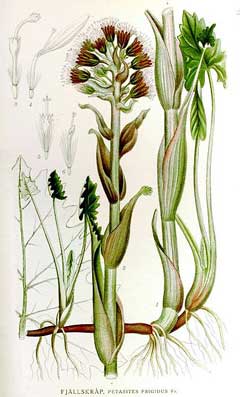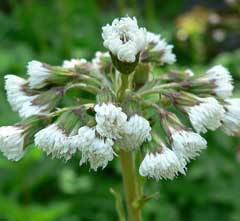 |
|
http://commons.wikimedia.org/wiki/File:Petasites_frigidus.jpg |
 |
| http://commons.wikimedia.org/wiki/User:Stan_Shebs |
Translate this page:
Summary
Bloom Color: Pink. Main Bloom Time: Late winter. Form: Spreading or horizontal.
Physical Characteristics

 Petasites frigidus is a PERENNIAL growing to 0.2 m (0ft 8in) by 1 m (3ft 3in) at a fast rate.
Petasites frigidus is a PERENNIAL growing to 0.2 m (0ft 8in) by 1 m (3ft 3in) at a fast rate.
See above for USDA hardiness. It is hardy to UK zone 5. It is in flower from April to May, and the seeds ripen from May to June. The species is dioecious (individual flowers are either male or female, but only one sex is to be found on any one plant so both male and female plants must be grown if seed is required). and is pollinated by Insects. The plant is not self-fertile.
Suitable for: light (sandy), medium (loamy) and heavy (clay) soils. Suitable pH: mildly acid, neutral and basic (mildly alkaline) soils. It can grow in full shade (deep woodland) semi-shade (light woodland) or no shade. It prefers moist or wet soil.
UK Hardiness Map
US Hardiness Map
Synonyms
P. speciosa. Tussilago frigida.
Plant Habitats
Woodland Garden Dappled Shade; Shady Edge; not Deep Shade; Ground Cover; Meadow; Bog Garden;
Edible Uses
Edible Parts: Flowers Leaves Root Stem
Edible Uses: Salt
Young leaves - raw or cooked[46, 61, 257]. They are mixed with other greens and used as a potherb[183, 257]. The leaves can also be made into a sauerkraut[257]. Young stalks and flower heads - cooked[183]. Roots - cooked[172, 183]. The burnt leaves are used as a salt substitute[172]. The stems and leaves, whilst still green, are rolled up into balls, dried and then placed on top of a very small fire on a rock and burned[207]. A very acceptable condiment for piñole[207].
References More on Edible Uses
Medicinal Uses
Plants For A Future can not take any responsibility for any adverse effects from the use of plants. Always seek advice from a professional before using a plant medicinally.
Antispasmodic Pectoral Poultice
Antispasmodic, poultice[172]. An infusion of the dried leaves has been used in the treatment of colds, head and chest congestion[257].
References More on Medicinal Uses
The Bookshop: Edible Plant Books
Our Latest books on Perennial Plants For Food Forests and Permaculture Gardens in paperback or digital formats.

Edible Tropical Plants
Food Forest Plants for Hotter Conditions: 250+ Plants For Tropical Food Forests & Permaculture Gardens.
More

Edible Temperate Plants
Plants for Your Food Forest: 500 Plants for Temperate Food Forests & Permaculture Gardens.
More

More Books
PFAF have eight books available in paperback and digital formats. Browse the shop for more information.
Shop Now
Other Uses
Containers Stuffing
A good ground cover for the wilder areas of the garden[200]. The cotton-like seed heads have been used as a stuffing material for mattresses[257]. The leaves have sometimes been folded into conical containers for collecting fruit[257]. They have also been used to make a temporary funnel[257].
Special Uses
Ground cover
References More on Other Uses
Cultivation details
Landscape Uses:Seashore, Woodland garden. Succeeds in ordinary garden soil[1], but prefers a deep fertile humus-rich soil that is permanently moist but not stagnant, succeeding in shade, semi-shade or full sun[200]. Prefers partial shade[31]. Plants can be grown in quite coarse grass, which can be cut annually in the autumn[233]. A very invasive plant, too rampant for anything other than the wild garden[187, 200]. Dioecious, male and female plants must be grown if seed is required. Special Features:Attractive foliage, North American native, Invasive, Wetlands plant.
References Carbon Farming Information and Carbon Sequestration Information
Temperature Converter
Type a value in the Celsius field to convert the value to Fahrenheit:
Fahrenheit:
The PFAF Bookshop
Plants For A Future have a number of books available in paperback and digital form. Book titles include Edible Plants, Edible Perennials, Edible Trees,Edible Shrubs, Woodland Gardening, and Temperate Food Forest Plants. Our new book is Food Forest Plants For Hotter Conditions (Tropical and Sub-Tropical).
Shop Now
Plant Propagation
Seed - we have no information on this species but suggest sowing the seed in a cold frame as soon as it is ripe or in early spring. Only just cover the seed and do not allow the compost to dry out. When they are large enough to handle, prick the seedlings out into individual pots and plant them out in the summer. Division succeeds at almost any time of the year. Very easy, larger divisions can be planted out direct into their permanent positions. We have found that it is better to pot up the smaller divisions and grow them on in light shade in a cold frame until they are well established before planting them out in late spring or early summer.
Other Names
If available other names are mentioned here
Native Range
TEMPERATE ASIA: Russian Federation-Western Siberia (Western Siberia), Russian Federation-Eastern Siberia (Eastern Siberia), Russian Federation (Krasnoyarsk, Tyva, Respublika) NORTHERN AMERICA: Canada (Northwest Territories, Yukon, Alberta, British Columbia), United States (Alaska, Connecticut, Maine, Massachusetts, Michigan, New Hampshire, New York, Rhode Island, Vermont, Minnesota, North Dakota, Wisconsin, Idaho, Montana, Oregon, Washington, California) EUROPE: Finland, Norway, Sweden, Russian Federation-European part (European part)
Weed Potential
Right plant wrong place. We are currently updating this section.
Please note that a plant may be invasive in one area but may not in your area so it's worth checking.
Conservation Status
IUCN Red List of Threatened Plants Status :

Growth: S = slow M = medium F = fast. Soil: L = light (sandy) M = medium H = heavy (clay). pH: A = acid N = neutral B = basic (alkaline). Shade: F = full shade S = semi-shade N = no shade. Moisture: D = dry M = Moist We = wet Wa = water.
Now available:
Food Forest Plants for Mediterranean Conditions
350+ Perennial Plants For Mediterranean and Drier Food Forests and Permaculture Gardens.
[Paperback and eBook]
This is the third in Plants For A Future's series of plant guides for food forests tailored to
specific climate zones. Following volumes on temperate and tropical ecosystems, this book focuses
on species suited to Mediterranean conditions—regions with hot, dry summers and cool, wet winters,
often facing the added challenge of climate change.
Read More
Expert comment
Author
(L.)Fries.
Botanical References
5060200
Links / References
For a list of references used on this page please go here
Readers comment
| Add a comment |
|
If you have important information about this plant that may help other users please add a comment or link below. Only comments or links that are felt to be directly relevant to a plant will be included. If you think a comment/link or information contained on this page is inaccurate or misleading we would welcome your feedback at [email protected]. If you have questions about a plant please use the Forum on this website as we do not have the resources to answer questions ourselves.
* Please note: the comments by website users are not necessarily those held by PFAF and may give misleading or inaccurate information.
To leave a comment please Register or login here All comments need to be approved so will not appear immediately.
|
Subject : Petasites frigidus
|
|
|
|